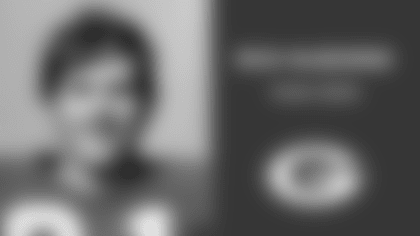After finishing in the top five in third-down offense each of the past two seasons, Green Bay's uncharacteristic struggles in that area during the first half of the season were highlighted by a four-game stretch leading into the Dallas game that featured a 25.5 percent conversion rate (13-of-51).
Against the Cowboys, the offense came up with the finest performance on third down by a Green Bay team in more than five years, converting on 10-of-15 third-down opportunities (66.7 percent) on its way to 415 total yards and a season-high 71 plays in the 45-7 victory. The effort against Dallas helped elevate the Packers 13 spots in the league third-down rankings, with Green Bay now checking in tied for No. 13 with a 39.4 percentage this season.
"We didn't really do anything magical schematically," Head Coach Mike McCarthy said. "We just executed better. Our pass protection (one sack) was good against a very good front. I think we were 7-8 in the first half, and I thought Aaron (Rodgers) did a very good job of going through his progressions. He extended some plays. Just a much better job executing and it's a credit to our players."
The players certainly did their part, but the decision by McCarthy and his coaching staff to simplify things a bit and focus more on what the offense had done well also factored in the improved showing.
"I have been cutting throughout the year," McCarthy said. "I think that we probably got a little too heavy in the beginning of the year, and just the fact that we were coming out of training camp. The norm is to go real low in the beginning of the year, but with the number of weapons that we had to start the season, we probably went a little higher in certain situations.
"It's not really a big deal. We're talking about a handful of plays. It really comes down to concentrating on the concepts that we can hang our hat on. Frankly we went into the Dallas game, we just acknowledged that these are the three or four things we feel we do very well and that's the way we played the game."
Offensive coordinator Joe Philbin said Rodgers was a bit more decisive and was able to get rid of the ball quicker against Dallas, a natural byproduct of running plays that he and the rest of the offense had more familiarity with.
"I threw the ball better than I had on third down up until that point," Rodgers said. "I think we just ran a lot of plays that we have a lot of reps in and guys made plays after the catch. I hit James (Jones) for a slant and he took it about 40 yards down the sideline. It was just kind of base plays and we ran them better than they could stop us.
"I think when you lower the volume and give the offense more plays that we have reps in and we have a lot of time invested in, you are going to run those plays a little bit better than the newer plays."
Green Bay was one of the most prolific offenses in the league on third down in '09, ranking No. 3 in the NFL at 47.0 percent behind only Indianapolis (49.2) and New England (49.0). Rodgers led the league with a 133.5 passer rating on third down, the highest number posted by an NFL signal-caller since Kurt Warner's 137.3 rating in 1999 with St. Louis. But Philbin said the offense may have become a victim of that success it enjoyed on third down, with the volume of the offensive menu continuing to increase.
"Part of the thing you have to decide as you are planning against any opponent is certainly there are a lot of excellent defensive coaches in the league and they're not always going to give you one coverage or one front or one particular blitz," Philbin said. "You kind of weight the options of, 'OK, do we give the quarterback the flexibility to change the protection, to change the route concept if we see something and we have something better out of that formation that we didn't call in the huddle.'
"Sometimes it is a great thing, and we've had our share of great adjustments by Aaron at the line of scrimmage. But everything you add to the quarterback's plate, that is something more he has to think about, he has to process. There is that balance between having enough flexibility in your packages that you can attack the coverages you are seeing without bogging down players with too much information."
On Sunday, Green Bay will face a Minnesota defense that hasn't been as productive this season on third down compared to 2009. Through Week 10, the Vikings rank No. 26 in the league in the category (41.8 percent), a noticeable drop from last season when they finished No. 3 in the league at 34.5 percent.
The Packers were efficient on third down (6-of-11) in the 28-24 win over the Vikings in Week 7, and staying in manageable down-and-distances weighed heavily in that success. Of those 11 opportunities, eight of them were third-and-6 or less. Only once all evening did the Packers need to pick up 10 yards or more, a 15-yard completion from Rodgers in the fourth quarter on third-and-11.
Avoiding those long-yardage situations will be critical, as Minnesota has allowed its opponents to convert just 22.6 percent of the time (14-of-62) when they need to pick up more than 6 yards on third down this season, compared to a 61.7 percent rate (37-of-60) on third-and-6 or less.
The Vikings haven't registered the kind of sack numbers they did last season either when they led the league with 48. Minnesota has posted just 14 sacks in 10 games this year (tied for No. 24 in the NFL), but has come on late with eight of them in the past two games, including a season-high six against Arizona two weeks ago at Mall of America Field.
"They have still gotten to the quarterback pretty well," Philbin said. "They have impacted the pocket. The Arizona game they got very good pressure on (Derek) Anderson. The Dallas game I think they got good pressure on (Tony) Romo. (Jay) Cutler made some plays with his feet (Sunday at Chicago).
"I think they still have a very formidable pass rush. Sometimes those numbers can be deceiving. I still think their rush is very, very good, and it is better at home too than it is on the road, that's for sure."
The Vikings' home-field advantage (17-3 in their last 20 games) is undeniable, and the Packers know that sustaining drives by converting third downs will go a long way toward keeping the crowd from being a big factor on Sunday.
"We've got to play a good field-position game, no question about it," Philbin said. "I'm not sitting here saying we're going to score 12 times when we have the ball 11 or 12 times a game, but we've got to move the chains.
"If we have to punt the ball, pin them down there and get good field position and take advantage of it. And we've got to make some plays on our own, which we are capable of doing."
Additional coverage – Nov. 18














